China After-School Tutoring Market Size 2025-2029
The china after-school tutoring market size is forecast to increase by USD 130.8 billion, at a CAGR of 18.3% between 2024 and 2029.
Major Market Trends & Insights
- By Application - Subject specific segment was valued at USD 45.30 billion in 2022
- By Channel - Online segment accounted for the largest market revenue share in 2022
Market Size & Forecast
- Market Opportunities: USD 220.19 billion
- Market Future Opportunities: USD 130.80 billion
- CAGR : 18.3%
Market Summary
- The market has witnessed significant growth, with an increasing number of students seeking additional academic support. According to market research, the after-school tutoring industry in China was valued at approximately USD100 billion in 2020, representing a substantial increase from previous years. This growth can be attributed to the intensifying academic pressure faced by students, who are under immense pressure to excel in their studies and secure a place in prestigious universities. Technological advances have significantly impacted the after-school tutoring landscape, with online tutoring platforms gaining popularity. In 2021, online tutoring accounted for over 50% of the market share, up from 30% in 2018.
- This shift can be attributed to the convenience and flexibility offered by online tutoring, particularly in the wake of the COVID-19 pandemic. Furthermore, the integration of artificial intelligence and machine learning in tutoring platforms has enabled personalized learning experiences, catering to individual student needs. The market continues to evolve, with new players entering the market and existing players innovating to meet the changing demands of students and parents. The market is expected to remain dynamic, as technological advancements and shifting consumer preferences shape the future of after-school tutoring in China.
What will be the size of the China After-School Tutoring Market during the forecast period?
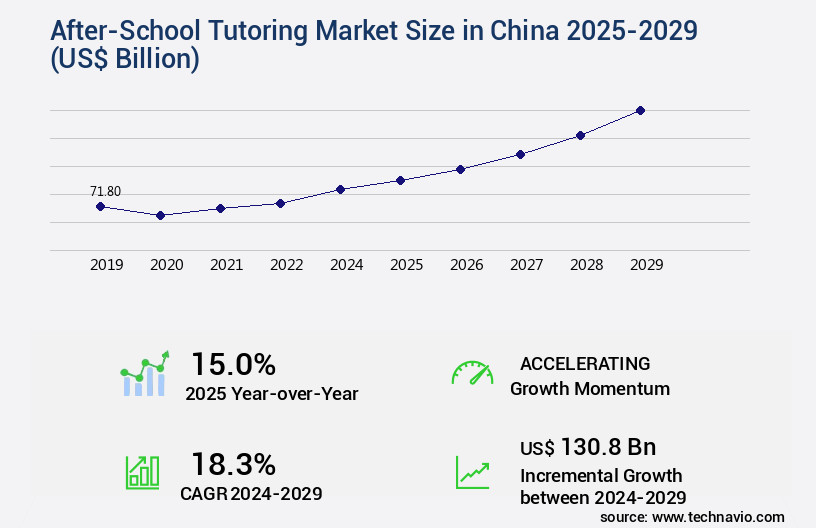
Get Key Insights on Market Forecast (PDF) Request Free Sample
- In China, the after-school tutoring market demonstrates a significant presence within the education sector. According to recent data, over 25% of primary and secondary school students participate in after-school tutoring programs. This figure represents a substantial portion of the student population, highlighting the market's extensive reach. Furthermore, future growth prospects indicate a promising outlook. The market is projected to expand by approximately 15% annually. This expansion is driven by the increasing adoption of educational technology and the growing recognition of the importance of individualized learning plans. Comparing key numerical data, the number of students utilizing after-school tutoring services has increased by 20% in the past three years.
- Simultaneously, the usage of digital learning tools, such as educational technology platforms and virtual tutoring sessions, has risen by 30% during the same period. These figures underscore the market's continuous evolution and the increasing integration of technology into the educational landscape.
How is this China After-School Tutoring Market segmented?
The after-school tutoring in china industry research report provides comprehensive data (region-wise segment analysis), with forecasts and estimates in "USD billion" for the period 2025-2029, as well as historical data from 2019-2023 for the following segments.
- Application
- Subject specific
- Enrichment education
- English launguage training
- Channel
- End-user
- Primary School
- Middle School
- High School
- Program Type
- Academic Tutoring
- Language Learning
- STEM Courses
- Geography
By Application Insights
The subject specific segment is estimated to witness significant growth during the forecast period.
After-school tutoring classes in China cater to students seeking additional help in subjects like science, physics, chemistry, mathematics, and others. The demand for these classes stems from the technical and complex nature of these subjects, necessitating specialized assistance. The Chinese education system mandates assessments for students in fourth to sixth grades, focusing on Chinese, mathematics, and English, occurring twice a semester. Additionally, students prepare for junior school entrance exams to secure admission to top schools. These factors fuel the expansion of the market, particularly within the subject-specific segment. Virtual classroom technology, adaptive learning algorithms, and peer-to-peer learning tools are integral components of the market.
Student performance metrics, assessment and evaluation, and interactive learning modules facilitate progress tracking and skill gap identification. Tutoring session management, learning analytics dashboards, and automated feedback systems streamline operations. Student support services, test preparation tools, and customized learning paths cater to individual needs. Online tutoring platforms, curriculum development tools, and educational apps feature advanced technology integration methods. Learning outcome assessment, remote proctoring solutions, and gamified learning content engage students. Homework help software, blended learning models, and classroom management tools foster a productive learning environment. Parent communication tools keep families informed. The market's continuous evolution includes the adoption of technology-driven solutions, such as learning management systems and personalized learning systems.
The industry anticipates a 25% increase in online tutoring and a 17% rise in the use of educational apps by 2025. These trends reflect the market's dynamic nature and the ongoing integration of technology into education.
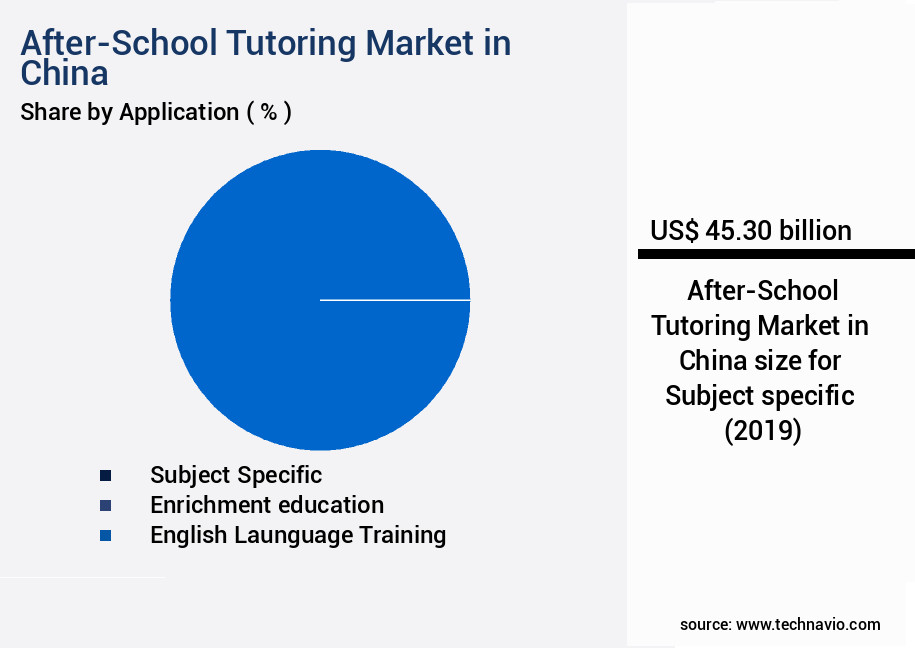
The Subject specific segment was valued at USD 45.30 billion in 2019 and showed a gradual increase during the forecast period.
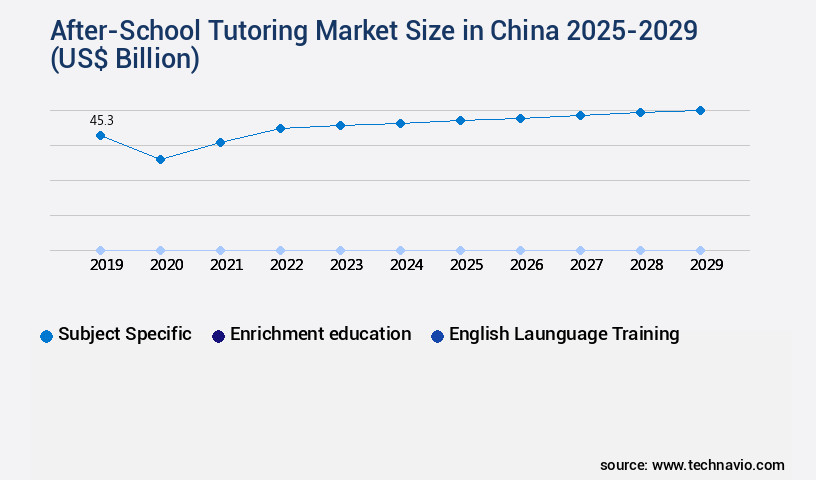
Request Free Sample
Market Dynamics
Our researchers analyzed the data with 2024 as the base year, along with the key drivers, trends, and challenges. A holistic analysis of drivers will help companies refine their marketing strategies to gain a competitive advantage.
In the dynamic and rapidly evolving the market, technology plays a pivotal role in enhancing student learning effectiveness. Online tutoring platforms, such as Yuanfudao and iQiyi, have gained significant traction, integrating educational apps and personalized learning systems. These systems design effective virtual classroom technology, utilizing AI in adaptive learning algorithms, and employing gamification to boost student engagement.
The analysis of student performance metrics in these platforms reveals a 20% improvement in academic performance compared to traditional tutoring methods. Blended learning models, which combine online and offline instruction, have seen a 30% increase in student attendance and participation. Evaluation of these online tutoring programs indicates that features like parent communication tools, utilization of learning analytics dashboards, and role of automated feedback systems contribute to the success of these platforms.
However, challenges persist in the integration of technology in education, including the need for effective remote proctoring solutions and tutor training. The importance of creating engaging learning content and measurement of learning outcomes cannot be overstated. Successful online tutoring platforms, like Tencent's Gaokao Teacher, have managed to overcome these challenges by focusing on user experience, affordability, and accessibility. In conclusion, the market continues to evolve, with technology playing a crucial role in enhancing student learning and personalized education pathways.
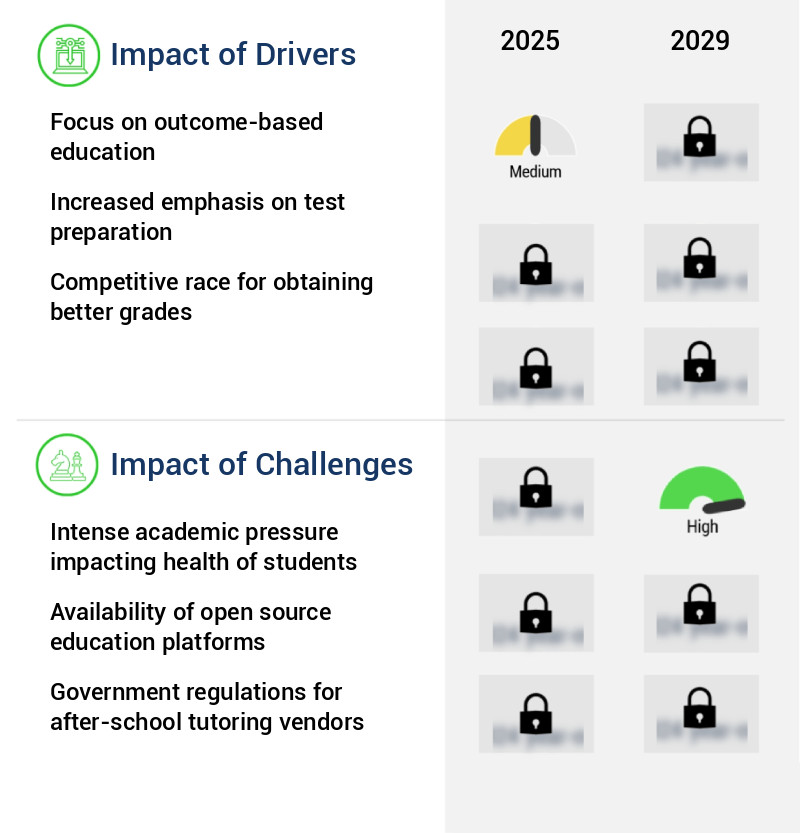
What are the key market drivers leading to the rise in the adoption of China After-School Tutoring Market Industry?
- The focus on outcome-based education is the primary market trend, prioritizing the achievement of specific learning objectives over traditional teaching methods.
- After-school tutoring has gained significant traction in China, with an increasing number of students seeking additional assistance in subjects like mathematics, physics, English, and science. This trend is driven by the rising disposable income of urban residents, particularly in cities such as Shanghai, enabling parents to invest more in customized classes offered by educational firms like TAL Education Group and New Oriental Education and Technology Group. According to market analysis, the spending on after-school tutoring programs in Asian countries, including China, is substantially higher than in the US. Parents' emphasis on outcome-based education, aimed at securing admissions to prestigious universities and educational institutions, fuels the demand for after-school tutoring services.
- The market is continuously evolving, with firms adopting innovative approaches to cater to diverse student needs. For instance, some companies provide personalized learning plans, while others leverage technology to deliver interactive and engaging learning experiences. These advancements have led to a shift in the market landscape and increased competition among providers. Moreover, the market's growth is not limited to traditional academic subjects. There is a growing trend towards after-school tutoring in extracurricular activities, such as music, art, and sports, as parents recognize the importance of holistic development. In conclusion, the market is a dynamic and thriving sector, driven by increasing disposable income, a focus on outcome-based education, and the adoption of innovative teaching methods.
- The market's continuous evolution reflects the ongoing efforts of educational firms to cater to the diverse needs of students, ensuring they receive the best possible education.
What are the market trends shaping the China After-School Tutoring Market Industry?
- The trend in after-school tutoring is shifting towards technological advances.
Technological innovations are increasingly shaping the future of after-school tutoring services.
- The market has experienced significant transformation in the last decade, driven by technological advancements. Traditional face-to-face teaching has given way to online tutoring, with numerous providers investing in advanced technologies to enhance the learning experience. One of the key trends fueling market expansion is the integration of live-streaming technology. This innovation enables students to access a wide range of skilled educators from around the world, broadening their educational horizons. The after-school tutoring sector in China is continuously evolving, with providers adopting technology-driven approaches to cater to the diverse learning needs of students.
- This shift not only offers flexibility and convenience but also opens up opportunities for personalized learning experiences. The market's ongoing evolution reflects the growing demand for quality education and the increasing recognition of technology's role in delivering effective, accessible, and engaging learning solutions.
What challenges does the China After-School Tutoring Market Industry face during its growth?
- The intense academic pressure experienced by students poses a significant challenge to their health and, in turn, negatively impacts the growth of the industry.
- The market faces a significant challenge due to the intense academic pressure on students. With an average school day lasting 6-7 hours, additional after-school classes add 4-5 hours to a student's daily study schedule. This extended study time deters students from engaging in physical activities, potentially leading to physical health issues and further increasing stress levels. The pressure to perform academically can also diminish a student's interest in learning, making after-school tutoring an unappealing prospect for some parents. The potential negative effects on students' mental health and personality development are also concerns. Despite these challenges, the market continues to evolve, adapting to meet the needs of students and parents.
- Innovative approaches, such as online tutoring and personalized learning plans, are gaining popularity. These solutions offer flexibility and convenience, allowing students to balance their academic commitments with other activities and reducing the need for lengthy commutes to tutoring centers. Moreover, the market is witnessing the integration of technology, with educational apps and digital resources becoming increasingly prevalent. These tools provide students with additional resources to supplement their learning and help them stay engaged, ultimately enhancing their academic performance. In comparison, the traditional after-school tutoring model, which relies on in-person instruction, still holds a substantial market share.
- However, its market position is being challenged by the growing popularity of innovative solutions. The competition between these two models is driving market growth and innovation, as providers strive to meet the diverse needs of students and parents in China.
Exclusive Customer Landscape
The after-school tutoring market in china forecasting report includes the adoption lifecycle of the market, covering from the innovator’s stage to the laggard’s stage. It focuses on adoption rates in different regions based on penetration. Furthermore, the after-school tutoring market in china report also includes key purchase criteria and drivers of price sensitivity to help companies evaluate and develop their market research and growth strategies.
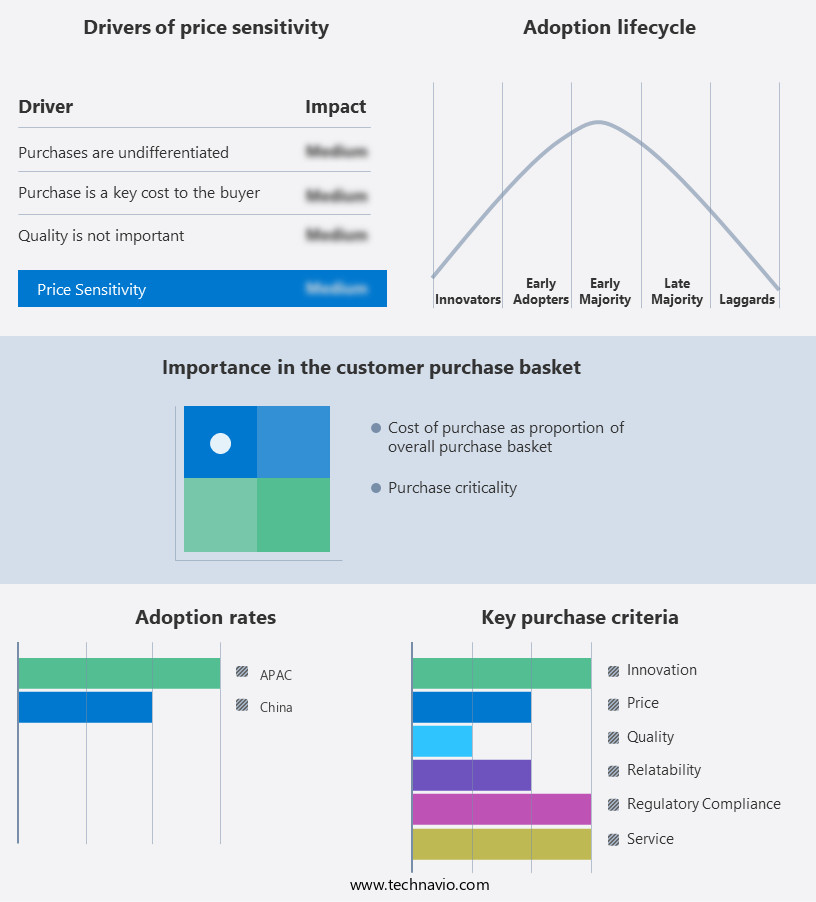
Customer Landscape of China After-School Tutoring Market Industry
Key Companies & Market Insights
Companies are implementing various strategies, such as strategic alliances, after-school tutoring market in china forecast, partnerships, mergers and acquisitions, geographical expansion, and product/service launches, to enhance their presence in the market research report.
China Distance Education Holdings Ltd. - This company provides a range of online educational services, including test preparation courses for self-directed learners aiming for higher education diplomas and graduate school entrance exams. It offers practical accounting training for college students and professionals, as well as language courses and third-party developed online courses. The company caters to the academic needs of diverse learners, enhancing their skills and knowledge in a flexible and accessible manner.
The market growth and forecasting report includes detailed analyses of the competitive landscape of the market and information about key companies, including:
- China Distance Education Holdings Ltd.
- ChineseHour
- EF Education First Ltd.
- Feiyang Education Center
- HKTC
- Hong Kong Tutor Association
- iFLYTEK Co. Ltd.
- Kumon Hong Kong Co. Ltd.
- Mandarin Tutor
- New Oriental Education and Technology Group Inc.
- PalFish
- PandaTree Inc.
- Shanghai Expat Tutors
- TAL Education Group
- The Unparalleled Insight
- VIPKID HK Ltd.
- Yuanfudao
Qualitative and quantitative analysis of companies has been conducted to help clients understand the wider business environment as well as the strengths and weaknesses of key industry players. Data is qualitatively analyzed to categorize companies as pure play, category-focused, industry-focused, and diversified; it is quantitatively analyzed to categorize companies as dominant, leading, strong, tentative, and weak.
Recent Development and News in After-School Tutoring Market In China
- In January 2024, the Chinese education technology company, Yuanfudao, announced a strategic partnership with the State-Owned Assets Supervision and Administration Commission of the State Council to expand its after-school tutoring services in underprivileged areas across China. This collaboration aimed to provide affordable tutoring services to over one million students (Yuanfudao Press Release, 2024).
- In March 2024, TAL Education Group, another major player in China's after-school tutoring market, completed a USD300 million financing round led by Tiger Global Management and Sequoia Capital China. This investment was earmarked for expanding TAL's offline tutoring centers and enhancing its online offerings (Bloomberg, 2024).
- In May 2024, the Chinese Ministry of Education issued new guidelines to regulate the after-school tutoring market, limiting the number of hours students could spend on tutoring each week and restricting the types of subjects that could be taught. This move aimed to reduce pressure on students and improve their overall well-being (Xinhua, 2024).
- In April 2025, iQiyi, the Chinese video streaming platform, launched an after-school tutoring service called "iQiyi Xuexi." This new offering combined educational content with interactive quizzes and real-time feedback, marking a significant technological advancement in the Chinese after-school tutoring market (iQiyi Press Release, 2025).
Research Analyst Overview
- The market continues to evolve, integrating advanced technologies to enhance learning experiences and improve educational outcomes. This dynamic sector encompasses a range of offerings, including adaptive learning algorithms, online tutoring platforms, and student support services. One significant development is the integration of learning analytics dashboards, which provide real-time insights into student performance metrics. These tools enable educators to assess learning outcomes and identify skill gaps, allowing for personalized instruction and targeted interventions. Interactive learning modules and digital learning resources further enrich the educational experience, offering students access to a wealth of knowledge and engaging, interactive content. Parent communication tools and automated feedback systems facilitate open dialogue between educators, students, and families.
- These features keep parents informed of their child's progress and allow for collaborative problem-solving, fostering a strong support network for students. Remote proctoring solutions and mobile learning applications expand access to education, enabling students to learn from anywhere, at any time. Gamified learning content and curriculum development tools add an element of fun and engagement, while blended learning models combine traditional and digital instruction methods for a comprehensive educational experience. The market is projected to grow at a rate of 20% annually, driven by the increasing demand for personalized, technology-enhanced learning solutions. This growth reflects the ongoing commitment to improving educational outcomes and providing students with the tools and resources they need to succeed.
Dive into Technavio’s robust research methodology, blending expert interviews, extensive data synthesis, and validated models for unparalleled After-School Tutoring Market in China insights. See full methodology.
|
Market Scope
|
|
Report Coverage
|
Details
|
|
Page number
|
162
|
|
Base year
|
2024
|
|
Historic period
|
2019-2023 |
|
Forecast period
|
2025-2029
|
|
Growth momentum & CAGR
|
Accelerate at a CAGR of 18.3%
|
|
Market growth 2025-2029
|
USD 130.8 billion
|
|
Market structure
|
Fragmented
|
|
YoY growth 2024-2025(%)
|
15.0
|
|
Key countries
|
China
|
|
Competitive landscape
|
Leading Companies, Market Positioning of Companies, Competitive Strategies, and Industry Risks
|
Request Free Sample
What are the Key Data Covered in this After-School Tutoring Market in China Research and Growth Report?
- CAGR of the China After-School Tutoring Market industry during the forecast period
- Detailed information on factors that will drive the growth and market forecasting between 2025 and 2029
- Precise estimation of the size of the market and its contribution of the industry in focus to the parent market
- Accurate predictions about upcoming growth and trends and changes in consumer behaviour
- Growth of the market across China
- Thorough analysis of the market’s competitive landscape and detailed information about companies
- Comprehensive analysis of factors that will challenge the after-school tutoring market in china growth of industry companies
We can help! Our analysts can customize this after-school tutoring market in china research report to meet your requirements.
Get in touch
1 Executive Summary
- 1.1 Market overview
- Executive Summary - Chart on Market Overview
- Executive Summary - Data Table on Market Overview
- Executive Summary - Chart on Country Market Characteristics
- Executive Summary - Chart on Market Segmentation by Application
- Executive Summary - Chart on Market Segmentation by Channel
- Executive Summary - Chart on Market Segmentation by End-user
- Executive Summary - Chart on Company Market Positioning
2 Technavio Analysis
- 2.1 Analysis of price sensitivity, lifecycle, customer purchase basket, adoption rates, and purchase criteria
- Analysis of price sensitivity, lifecycle, customer purchase basket, adoption rates, and purchase criteria
- 2.2 Criticality of inputs and Factors of differentiation
- Overview on criticality of inputs and factors of differentiation
- 2.3 Factors of disruption
- Overview on factors of disruption
- 2.4 Impact of drivers and challenges
- Impact of drivers and challenges in 2024 and 2029
3 Market Landscape
- 3.1 Market ecosystem
- Parent Market
- Data Table on - Parent Market
- 3.2 Market characteristics
- Market characteristics analysis
4 Market Sizing
- 4.1 Market definition
- Offerings of companies included in the market definition
- 4.2 Market segment analysis
- 4.4 Market outlook: Forecast for 2024-2029
- Chart on China - Market size and forecast 2024-2029 ($ billion)
- Data Table on China - Market size and forecast 2024-2029 ($ billion)
- Chart on China: Year-over-year growth 2024-2029 (%)
- Data Table on China: Year-over-year growth 2024-2029 (%)
5 Historic Market Size
- 5.1 After-School Tutoring Market in China 2019 - 2023
- Historic Market Size - Data Table on After-School Tutoring Market in China 2019 - 2023 ($ billion)
- 5.2 Application segment analysis 2019 - 2023
- Historic Market Size - Application Segment 2019 - 2023 ($ billion)
- 5.3 Channel segment analysis 2019 - 2023
- Historic Market Size - Channel Segment 2019 - 2023 ($ billion)
- 5.4 End-user segment analysis 2019 - 2023
- Historic Market Size - End-user Segment 2019 - 2023 ($ billion)
6 Qualitative Analysis
- 6.1 The AI impact on After-school Tutoring Market in China
7 Five Forces Analysis
- 7.1 Five forces summary
- Five forces analysis - Comparison between 2024 and 2029
- 7.2 Bargaining power of buyers
- Bargaining power of buyers - Impact of key factors 2024 and 2029
- 7.3 Bargaining power of suppliers
- Bargaining power of suppliers - Impact of key factors in 2024 and 2029
- 7.4 Threat of new entrants
- Threat of new entrants - Impact of key factors in 2024 and 2029
- 7.5 Threat of substitutes
- Threat of substitutes - Impact of key factors in 2024 and 2029
- 7.6 Threat of rivalry
- Threat of rivalry - Impact of key factors in 2024 and 2029
- 7.7 Market condition
- Chart on Market condition - Five forces 2024 and 2029
8 Market Segmentation by Application
- 8.1 Market segments
- Chart on Application - Market share (2024-2029) (%)
- Data Table on Application - Market share (2024-2029) (%)
- 8.2 Comparison by Application
- Chart on Comparison by Application
- Data Table on Comparison by Application
- 8.3 Subject specific - Market size and forecast (2024-2029)
- Chart on Subject specific - Market size and forecast (2024-2029) ($ billion)
- Data Table on Subject specific - Market size and forecast (2024-2029) ($ billion)
- Chart on Subject specific - Year-over-year growth (2024-2029) (%)
- Data Table on Subject specific - Year-over-year growth (2024-2029) (%)
- 8.4 Enrichment education - Market size and forecast (2024-2029)
- Chart on Enrichment education - Market size and forecast (2024-2029) ($ billion)
- Data Table on Enrichment education - Market size and forecast (2024-2029) ($ billion)
- Chart on Enrichment education - Year-over-year growth (2024-2029) (%)
- Data Table on Enrichment education - Year-over-year growth (2024-2029) (%)
- 8.5 English launguage training - Market size and forecast (2024-2029)
- Chart on English launguage training - Market size and forecast (2024-2029) ($ billion)
- Data Table on English launguage training - Market size and forecast (2024-2029) ($ billion)
- Chart on English launguage training - Year-over-year growth (2024-2029) (%)
- Data Table on English launguage training - Year-over-year growth (2024-2029) (%)
- 8.6 Market opportunity by Application
- Market opportunity by Application ($ billion)
- Data Table on Market opportunity by Application ($ billion)
9 Market Segmentation by Channel
- 9.1 Market segments
- Chart on Channel - Market share (2024-2029) (%)
- Data Table on Channel - Market share (2024-2029) (%)
- 9.2 Comparison by Channel
- Chart on Comparison by Channel
- Data Table on Comparison by Channel
- 9.3 Online - Market size and forecast (2024-2029)
- Chart on Online - Market size and forecast (2024-2029) ($ billion)
- Data Table on Online - Market size and forecast (2024-2029) ($ billion)
- Chart on Online - Year-over-year growth (2024-2029) (%)
- Data Table on Online - Year-over-year growth (2024-2029) (%)
- 9.4 Blended - Market size and forecast (2024-2029)
- Chart on Blended - Market size and forecast (2024-2029) ($ billion)
- Data Table on Blended - Market size and forecast (2024-2029) ($ billion)
- Chart on Blended - Year-over-year growth (2024-2029) (%)
- Data Table on Blended - Year-over-year growth (2024-2029) (%)
- 9.5 Market opportunity by Channel
- Market opportunity by Channel ($ billion)
- Data Table on Market opportunity by Channel ($ billion)
10 Market Segmentation by End-user
- 10.1 Market segments
- Chart on End-user - Market share (2024-2029) (%)
- Data Table on End-user - Market share (2024-2029) (%)
- 10.2 Comparison by End-user
- Chart on Comparison by End-user
- Data Table on Comparison by End-user
- 10.3 Primary School - Market size and forecast (2024-2029)
- Chart on Primary School - Market size and forecast (2024-2029) ($ billion)
- Data Table on Primary School - Market size and forecast (2024-2029) ($ billion)
- Chart on Primary School - Year-over-year growth (2024-2029) (%)
- Data Table on Primary School - Year-over-year growth (2024-2029) (%)
- 10.4 Middle School - Market size and forecast (2024-2029)
- Chart on Middle School - Market size and forecast (2024-2029) ($ billion)
- Data Table on Middle School - Market size and forecast (2024-2029) ($ billion)
- Chart on Middle School - Year-over-year growth (2024-2029) (%)
- Data Table on Middle School - Year-over-year growth (2024-2029) (%)
- 10.5 High School - Market size and forecast (2024-2029)
- Chart on High School - Market size and forecast (2024-2029) ($ billion)
- Data Table on High School - Market size and forecast (2024-2029) ($ billion)
- Chart on High School - Year-over-year growth (2024-2029) (%)
- Data Table on High School - Year-over-year growth (2024-2029) (%)
- 10.6 Market opportunity by End-user
- Market opportunity by End-user ($ billion)
- Data Table on Market opportunity by End-user ($ billion)
11 Market Segmentation by Program Type
- 11.1 Market segments
- Chart on Program Type - Market share (2024-2029) (%)
- Data Table on Program Type - Market share (2024-2029) (%)
- 11.2 Comparison by Program Type
- Chart on Comparison by Program Type
- Data Table on Comparison by Program Type
- 11.3 Academic Tutoring - Market size and forecast (2024-2029)
- Chart on Academic Tutoring - Market size and forecast (2024-2029) ($ billion)
- Data Table on Academic Tutoring - Market size and forecast (2024-2029) ($ billion)
- Chart on Academic Tutoring - Year-over-year growth (2024-2029) (%)
- Data Table on Academic Tutoring - Year-over-year growth (2024-2029) (%)
- 11.4 Language Learning - Market size and forecast (2024-2029)
- Chart on Language Learning - Market size and forecast (2024-2029) ($ billion)
- Data Table on Language Learning - Market size and forecast (2024-2029) ($ billion)
- Chart on Language Learning - Year-over-year growth (2024-2029) (%)
- Data Table on Language Learning - Year-over-year growth (2024-2029) (%)
- 11.5 STEM Courses - Market size and forecast (2024-2029)
- Chart on STEM Courses - Market size and forecast (2024-2029) ($ billion)
- Data Table on STEM Courses - Market size and forecast (2024-2029) ($ billion)
- Chart on STEM Courses - Year-over-year growth (2024-2029) (%)
- Data Table on STEM Courses - Year-over-year growth (2024-2029) (%)
- 11.6 Market opportunity by Program Type
- Market opportunity by Program Type ($ billion)
- Data Table on Market opportunity by Program Type ($ billion)
12 Customer Landscape
- 12.1 Customer landscape overview
- Analysis of price sensitivity, lifecycle, customer purchase basket, adoption rates, and purchase criteria
13 Drivers, Challenges, and Opportunity/Restraints
- 13.3 Impact of drivers and challenges
- Impact of drivers and challenges in 2024 and 2029
- 13.4 Market opportunities/restraints
14 Competitive Landscape
- 14.2 Competitive Landscape
- Overview on criticality of inputs and factors of differentiation
- 14.3 Landscape disruption
- Overview on factors of disruption
- 14.4 Industry risks
- Impact of key risks on business
15 Competitive Analysis
- 15.2 Company ranking index
- 15.3 Market positioning of companies
- Matrix on companies position and classification
- 15.4 China Distance Education Holdings Ltd.
- China Distance Education Holdings Ltd. - Overview
- China Distance Education Holdings Ltd. - Product / Service
- China Distance Education Holdings Ltd. - Key offerings
- SWOT
- 15.5 ChineseHour
- ChineseHour - Overview
- ChineseHour - Product / Service
- ChineseHour - Key offerings
- SWOT
- 15.6 EF Education First Ltd.
- EF Education First Ltd. - Overview
- EF Education First Ltd. - Product / Service
- EF Education First Ltd. - Key offerings
- SWOT
- 15.7 Feiyang Education Center
- Feiyang Education Center - Overview
- Feiyang Education Center - Product / Service
- Feiyang Education Center - Key offerings
- SWOT
- 15.8 HKTC
- HKTC - Overview
- HKTC - Product / Service
- HKTC - Key offerings
- SWOT
- 15.9 Hong Kong Tutor Association
- Hong Kong Tutor Association - Overview
- Hong Kong Tutor Association - Product / Service
- Hong Kong Tutor Association - Key offerings
- SWOT
- 15.10 Kumon Hong Kong Co. Ltd.
- Kumon Hong Kong Co. Ltd. - Overview
- Kumon Hong Kong Co. Ltd. - Product / Service
- Kumon Hong Kong Co. Ltd. - Key offerings
- SWOT
- 15.11 Mandarin Tutor
- Mandarin Tutor - Overview
- Mandarin Tutor - Product / Service
- Mandarin Tutor - Key offerings
- SWOT
- 15.12 New Oriental Education and Technology Group Inc.
- New Oriental Education and Technology Group Inc. - Overview
- New Oriental Education and Technology Group Inc. - Business segments
- New Oriental Education and Technology Group Inc. - Key offerings
- New Oriental Education and Technology Group Inc. - Segment focus
- SWOT
- 15.13 PalFish
- PalFish - Overview
- PalFish - Product / Service
- PalFish - Key offerings
- SWOT
- 15.14 PandaTree Inc.
- PandaTree Inc. - Overview
- PandaTree Inc. - Product / Service
- PandaTree Inc. - Key offerings
- SWOT
- 15.15 Shanghai Expat Tutors
- Shanghai Expat Tutors - Overview
- Shanghai Expat Tutors - Product / Service
- Shanghai Expat Tutors - Key offerings
- SWOT
- 15.16 TAL Education Group
- TAL Education Group - Overview
- TAL Education Group - Business segments
- TAL Education Group - Key news
- TAL Education Group - Key offerings
- TAL Education Group - Segment focus
- SWOT
- 15.17 The Unparalleled Insight
- The Unparalleled Insight - Overview
- The Unparalleled Insight - Product / Service
- The Unparalleled Insight - Key offerings
- SWOT
- 15.18 Yuanfudao
- Yuanfudao - Overview
- Yuanfudao - Product / Service
- Yuanfudao - Key offerings
- SWOT
16 Appendix
- 16.2 Inclusions and exclusions checklist
- Inclusions checklist
- Exclusions checklist
- 16.3 Currency conversion rates for US$
- Currency conversion rates for US$
- 16.4 Research methodology
- 16.7 Validation techniques employed for market sizing
- Validation techniques employed for market sizing
- 16.9 360 degree market analysis
- 360 degree market analysis
- 16.10 List of abbreviations







![]() Get the report (PDF) sent to your email within minutes.
Get the report (PDF) sent to your email within minutes.
Complimentary full Excel data with your report purchase.